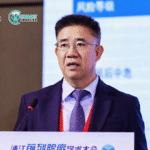
Editor’s Note: On June 27, 2025, the Pujiang Prostate Cancer Academic Congress was held in Shanghai, in conjunction with the Annual Meeting of the Chinese Society of Clinical Oncology Prostate Cancer Committee (CSCO-PC), the Prostate Cancer Meeting of the CACA Genitourinary Oncology Committee (CACA-GO), and the Annual Meeting of the Chinese Prostate Cancer Consortium (CPCC). The event gathered leading experts from around the world to discuss cutting-edge developments in prostate cancer treatment. Professor Lu Yang, Department of Urology, West China Hospital of Sichuan University, delivered a keynote presentation on recent advances in targeting the androgen receptor (AR) pathway in prostate cancer, providing important insights for clinical decision-making. He offered a comprehensive overview of the latest innovations in monotherapy, emerging evidence from combination strategies, and the translational potential of new technologies such as PROTACs and epigenetic modulators—while also addressing current challenges and future directions.01
AR Signaling: A Central Driver and Resistance Mechanism in Prostate Cancer
The androgen receptor (AR) signaling pathway plays a central role in the pathophysiology of prostate cancer progression and remains a key therapeutic target. Professor Yang emphasized that while AR-targeted therapies have shown significant clinical benefit, nearly all patients with advanced prostate cancer eventually progress to the castration-resistant stage (CRPC). Even in early CRPC, persistent AR activation remains detectable in up to 70% of patients. This is often driven by mechanisms such as AR gene amplification, point mutations, and the emergence of splice variants like AR-V7 and AR-V9. Overcoming resistance within the AR pathway and achieving more precise and durable inhibition has therefore become a major focus of research.
02
Monotherapy Advances: Mechanistic Innovations Drive Efficacy
In response to AR resistance, a new generation of AR-targeted agents is emerging with novel mechanisms of action.
EPI-7386: This agent uniquely targets both the ligand-binding domain (LBD) and the N-terminal domain (NTD) of the AR, aiming to more comprehensively block AR transcriptional activity. Phase I results have been promising, with 90% of patients achieving a ≥90% decline in PSA (PSA90), and 70% reaching undetectable PSA levels (<0.2 ng/mL), indicating strong antitumor efficacy.
Opevesostat (ODM-208): An oral CYP11A1 inhibitor, ODM-208 disrupts the first rate-limiting step in steroidogenesis, blocking the synthesis of all androgens and their precursors at the source. In the CYPIDES phase I/II trial, ODM-208 demonstrated significant activity in patients with mCRPC, including those harboring AR LBD mutations. A phase III trial, OMAHA-003, is now underway to evaluate its efficacy in patients previously treated with novel hormonal therapies and chemotherapy.
03
Combination Therapy: Synergistic Strategies to Improve Outcomes
Recognizing the limitations of monotherapy, researchers are increasingly investigating synergistic combinations.
ARPI + PARPI: The TALAPRO-2 trial, including updated results from ASCO GU 2025, showed that talazoparib combined with enzalutamide significantly improved radiographic progression-free survival (rPFS) and overall survival (OS) in both the overall population and patients with HRR mutations, particularly BRCA. These results established this combination as a new standard for HRR-mutated mCRPC. Further trials like AMPLITUDE and TALAPRO-3 are now exploring this strategy in the earlier metastatic castration-sensitive (mCSPC) setting.
ARPI + Radioligand Therapy: The ENZA-p study demonstrated that adding ¹⁷⁷Lu-PSMA radioligand therapy to enzalutamide significantly extended median OS (34 vs. 26 months) and improved quality of life. The magnitude of benefit led to nearly 40% of control patients crossing over to receive ¹⁷⁷Lu-PSMA.
ARPI + Epigenetic Modulators: Combining ARPIs with epigenetic therapies is also showing promise. EZH2 inhibitors (e.g., ceralasertib, mevrometostat) combined with enzalutamide extended rPFS by 8.1 months and improved PSA50 and ORR rates. These findings support the therapeutic potential of targeting histone methylation (e.g., H3K27me3). Multiple phase III trials in the MERLOT series are ongoing. Additionally, BET inhibitors (e.g., ZEN-3694), which target histone acetylation readers like BRD4, have shown preclinical and early clinical activity, particularly in neuroendocrine (NE) and double-negative (DN) prostate cancer subtypes by potentially reversing NE differentiation or resensitizing tumors to AR-targeted therapies.
Rethinking Combination Strategies: Professor Yang also noted that not all combinations succeed. Dual ARPI combinations and ARPI + PI3K/AKT inhibitors (e.g., atezolizumab in IMbassador250) have not yielded OS improvements. Likewise, immune checkpoint inhibitors combined with ARPIs (e.g., pembrolizumab + enzalutamide in KEYNOTE-641 and KEYNOTE-991) failed to meet primary endpoints in both mCRPC and mCSPC. However, the TRANSFORMER trial suggested that short-term bipolar androgen therapy (BAT) interspersed between ARPIs may help restore sensitivity, offering a novel approach to sequencing.
04
PROTACs: Targeted Protein Degradation for Undruggable Targets
PROTACs (proteolysis-targeting chimeras) represent a paradigm shift by harnessing the ubiquitin-proteasome system to selectively degrade proteins like AR, particularly those considered “undruggable.”
ARV-110 (Bavdegalutamide): This AR-directed PROTAC achieved a PSA50 response rate of 53.4% and a median rPFS of 11.1 months in patients with specific AR LBD mutations (e.g., T878A, H875Y) who had received 1–2 lines of AR-targeted therapy. CTC RNA biomarkers are also being explored to predict response.
BMS-986365: This agent not only degrades AR but also acts as a competitive AR inhibitor, offering a dual mechanism of action. In phase I trials, it induced PSA responses and prolonged rPFS in patients with prior ARPI failure, regardless of chemotherapy history. The phase III ReCHARGE trial is now underway—marking the first global phase III trial of a PROTAC targeting AR, a major milestone toward clinical translation.
05
Key Challenges and Future Directions: Precision and Sequencing
Professor Yang highlighted several pressing challenges:
- Immune Combination Limitations: Failures in the KEYNOTE series underscore the need for better patient stratification (e.g., molecular subtypes, tumor microenvironment features) and optimal timing. Understanding immune factors (e.g., IL-8, IL-6, IL-23, MDSCs, TAMs) and identifying robust biomarkers will be key to advancing immunotherapy combinations.
- Strategic Optimization: Moving effective combinations like ARPI + PARPI or ARPI + ¹⁷⁷Lu-PSMA earlier in treatment (e.g., mCSPC) is an emerging trend. However, this raises questions about balancing front-line intensification with preserving options for later lines of therapy—an issue requiring careful management of efficacy, toxicity, and sustainability.
- Precision Patient Selection: As more treatment modalities emerge (e.g., PARP inhibitors, PROTACs, radioligand therapy, epigenetic drugs, ADCs/PDCs), selecting patients based on biomarkers such as HRR mutations, AR mutations or splice variants, PSMA/STEAP1/B7-H3 expression, epigenetic signatures, and NE markers like DLL3 is becoming increasingly critical. Genomic testing and advanced imaging (e.g., PSMA-PET/CT) will play central roles.
- Redefining Endpoints: With the rise of radioligand therapy and advanced imaging, the appropriateness of rPFS as a primary endpoint needs to be re-evaluated. Future trials should consider more clinically meaningful endpoints that better reflect patient benefit.
- Overcoming Resistance: A deep understanding of mechanisms behind continued AR activation (e.g., via splice variants or coactivators) or complete AR escape (e.g., NE differentiation) is essential. Strategies such as targeting EZH2 or BET proteins, or re-sensitizing tumors to AR dependence, are key to achieving long-term disease control.
06
Conclusion
This presentation by Professor Lu Yang offered a thorough and insightful overview of the evolving landscape of AR-targeted therapies in prostate cancer—from next-generation monotherapies to combination approaches and cutting-edge technologies like PROTACs and epigenetic interventions. These advances are significantly expanding therapeutic options and improving outcomes for patients. The growing role of Chinese researchers and their contributions to global collaborations are increasingly evident. Looking ahead, deeper exploration of resistance mechanisms, strategic treatment sequencing, and biomarker-driven precision therapy will shape the next frontier of prostate cancer management.



